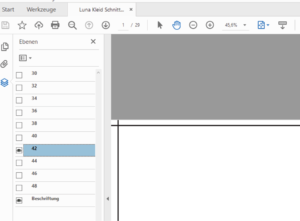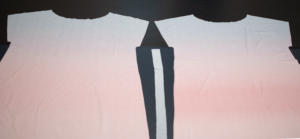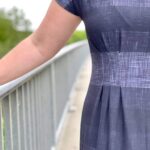zum Warenkorb 0,00 €
0Nähanleitung /// How to sew: Dione
Schnell genäht und raffiniert: Dione
Dione ist ein leicht zu nähendes, gut sitzendes Sommerkleid in zwei Längen: Normal und Maxi. Das Vorder- und Rückteil ist gleich, dank der kleinen Falten wird Dione jedoch zu einem absoluten Figurwunder.
Quickly sewn and clever: Dione
Dione is an easy-to-sew, well-fitting summer dress in two lengths: regular and maxi. The front and back are the same, but thanks to the small pleats, Dione becomes an absolute figure miracle.

Richtige Größe drucken
Print the correct size
Maßtabelle /// Size chart (cm)

Stoffempfehlung
Für Dione eignen sich am besten weich fallende Viskosejerseys oder Modaljerseys mit mindestens 5% Elasthananteil.
Fabric recommendation
Softly falling viscose jerseys or modal jerseys with at least 5% elastane are best suited for Dione.

Anpassung
Für dieses Schnittmuster sind alle drei Maße relevant: Oberweite, Taille und Hüfte. Weichen die Maße voneinander ab, muss unbedingt angepasst werden. Drucke nur die Größen aus, die du benötigst. In dem Beispiel haben wir nach Maßtabelle oben eine 36 und unten eine 40. Verbinde den oberen Teil der 36 mit dem unteren Teil der 40 mit einer sanft auslaufenden Linie. Für die Falten nutze die Markierungen der Größe, die du für die Taille ermittelt hast.
Solltest du Hilfe benötigen, schau gern in der Mondstoff-Gruppe auf Facebook vorbei: Mondstoff-Gruppe
Adjustment
All three measurements are relevant for this pattern: bust, waist and hips. If the dimensions deviate from each other, it is essential to adjust them. Print only the sizes you need. In the example, according to the size chart, we have a 36 at the top and a 40 at the bottom. Connect the upper part of the 36 to the lower part of the 40 with a gently fading line. For the pleats, use the markings of the size for the waist.
If you need help, feel free to join the Mondstoff group on Facebook: Mondstoff Group

Zuschnitt
Schneide das Kleid 2x im Bruch zu. Vorder- und Rückteil sind in diesem Fall gleich. Das Kleid wird durch die abgenähten Falten in Form gebracht. Schneide zudem einen Bündchenstreifen für den Halsausschnitt zu. Dieser ist mit 0,8 als Faktor berechnet. Je nach Stoffwahl kann hier aber ein Anpassen nötig sein.
Cutting
Cut the dress 2x on fold. The front and back are the same. The dress is brought into shape by the sewn-in folds. Also cut a cuff strip for the neckline. This is calculated with a factor of 0.8. Depending on the choice of fabric, an adjustment may be necessary here.

1. Passzeichen übertragen
Übertrage alle Abnäher und Passzeichen mit Hilfe eines Trickmarkers oder ähnlichem auf die linke Stoffseite.
1. Transfer the marks
Transfer all darts and marks to the wrong side of the fabric using a trick marker or something similar.

2. Falten stecken
Stecke zunächst die Falten zusammen. Nimm dafür am besten Stecknadeln zu Hilfe und stecke immer eine Nadel von links durch die Punktmarkierungen hindurch zur anderen Seite, sodass die Punkte oben und unten genau aufeinander liegen.
2. Pin the folds
First pin the folds together. It is best to use pins for this. Put a needle through the dot markings from the left to the other side so that the dots above and below match exactly.

3. Falten nähen
Nähe die Strecke zwischen den Punkten mit einem Geradstich (Stichlänge 2 – 2,5). Verriegle Anfang und Ende dabei sehr gründlich, damit die Naht beim Tragen später nicht aufgeht. Bügle die so entstandenen Falten jeweils zur vorderen und hinteren Mitte. Verfahre so mit Vorder- und Rückteil.
3. Sew the folds
Sew between the dots with a straight stitch (stitch length 2 – 2.5). Backstitch the beginning and end very thoroughly so that the seam doesn’t come undone later when you wear it. Iron the resulting folds towards the center front and center back. Do the same for the front and back pieces.

4. So sehen die Falten aus
Von rechts sehen die gebügelten Falten so aus.
4. The finished folds
From the right, the ironed folds look like this.

5. Schulter- und Seitennähte schließen
Schließe als nächstes beide Schulternähte und die Seitennähte. Es empfiehlt sich, das Kleid nun einmal anzuprobieren, um gegebenenfalls noch Anpassungen vorzunehmen. Das Kleid sollte in der Taille anliegend sitzen, an der Brust und Hüfte etwas Spiel haben.
5. Clothing the shoulder and side seams
Next, close both shoulder seams and the side seams. It’s a good idea to try the dress on now, to see if there’s anything else to make adjustments. The dress should fit snugly at the waist where chest and hips have some play.

6. Bündchen annähen
Wenn alles passt, schließe das Bündchen für den Halsausschnitt zum Ring und stecke es rechts auf rechts fest. Das Bündchen wird dabei etwas gedehnt, damit sich der Ausschnitt später schön anlegt. Nähe es mit einem elastischen Stich oder der Overlock an. Optional kannst du es knappkantig absteppen.
6. Sewing the Neck cuff
If everything fits, close the cuff for the neckline to a ring and pin it right sides together. The cuff is stretched a bit so that the neckline fits nicely later. Sew it on with an elastic stitch or the serger. Optionally, you can topstitch it.

7. Säumen
Säume den Rock mit 2,5 cm Saumzugabe, die Ärmel mit 0,7 cm Saumzugabe mit einem elastischen Stich oder einer Zwillingsnadel.
7. Hem
Hem the skirt with a 2.5 cm hem allowance, the sleeves with a 0.7 cm hem allowance with an elastic stitch or a twin needle.
















